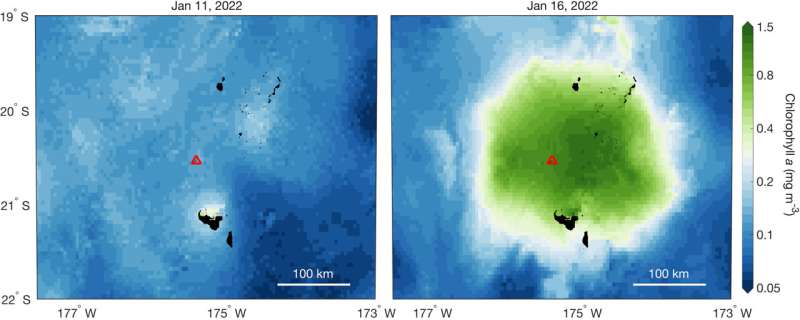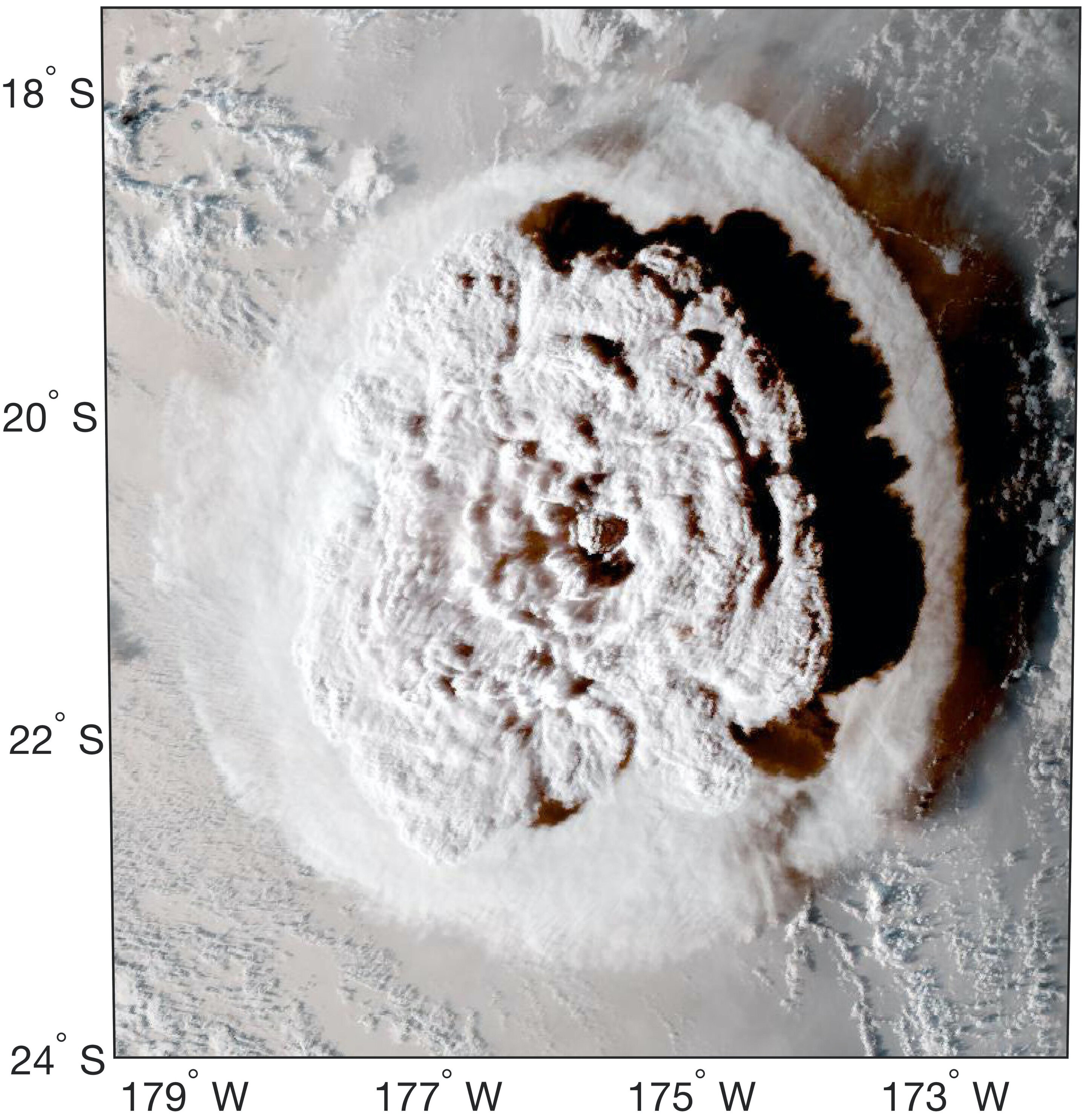The eruption of Hunga Tonga-Hunga Haʻapai as seen from the GOES satellite. Credit: NASA/NOAA
In January 2022, the largest underwater volcanic eruption this century caused a dramatic phytoplankton bloom north of Tongatapu Island in the Kingdom of Tonga. A team of scientists from the University of Hawaii (UH) at Mānoa and Oregon State University showed in a newly published study that a flourishing of microscopic marine life covered an area nearly 40 times the size of the island of Oahu in Hawaii J within just 48 hours of the eruption.
A team led by UH Mānoa’s School of Oceanic and Earth Sciences and Technology (SOEST) analyzed satellite images of various species – true color, emission of red and infrared radiationand the reflection of light on the surface of the sea – and determined that the deposition of volcanic ash is probably the most important source of nutrients responsible for phytoplankton growth.
Phytoplankton are tiny photosynthetic organisms that produce oxygen and serve as the backbone of the marine food web. The growth of these microbes is often limited by the low concentration of nutrients dissolved in the the surface of the oceanbut phytoplankton can increase rapidly as nutrients become available.
“Although the Hunga Tonga-Hunga Haʻapai eruption was underwater, a large plume of ash reached a height of tens of kilometers into the atmosphere,” said Benedetto Barone, lead author of the study and an oceanographer at the Center for Microbial Oceanography: Research and Education (C-MORE ) in SOEST. “Ash fallout provided nutrients that stimulated phytoplankton growth, with concentrations well above typical values seen in the region.”
“We were impressed to see such a large area with high chlorophyll concentration in such a short time after the eruption,” said Dave Karl, co-author of the study and director of C-MORE. “It shows how quickly an ecosystem can respond to nutrient fertilization.”
“A casual observer can see seemingly very different parts of the environment – in this case, a volcano that causes a strong eruption and significant changes in the ecology of the oceans nearby,” said Ken Rubin, study co-author and a volcanologist in SOEST’s Department of Earth Sciences. “However, our observations illustrate the extensive interconnectedness and interdependence of different aspects of the environment, perhaps even pointing to an underappreciated link between volcanism and shallow marine ecosystems worldwide.”

Maps of chlorophyll in the ocean before (left) and after (right) the eruption. Credit: Barone et al. (2022)
Applying the Lessons of Kilauea
Three of the study’s authors previously assessed and sampled smaller phytoplankton blooms associated with the 2018 Kilauea eruption, highlighting the volcano’s potential impact on the ocean ecosystems.
“When I heard about the Tonga eruption, it was fairly easy to modify the computer code I wrote to analyze satellite measurements around Hawaii to determine the impact of the Tonga eruption on the nearby ocean ecosystem,” Barone said. “From the first moment we saw the results of the analysis, it was clear that there was a rapid phytoplankton response in a large region.”
Understanding ocean fertilization
Phytoplankton are extracted from the atmosphere carbon dioxide which is responsible for the warming of most regions of our planet. The an eruption was a natural fertilization that revealed the ability of these microscopic powerhouses to respond quickly when the right conditions arise.
“The dynamics of this event can help us predict the behavior of the pelagic environment when nutrients are added to nutrient-depleted regions of the ocean,” Barone said. “This knowledge may prove useful in the debate about the impact of carbon removal technologies based on ocean fertilization.”
B. Barone and others. Satellite detection of a massive phytoplankton bloom following the underwater eruption of the 2022 Hunga Tonga-Hunga Haapai volcano, Geophysical Research Letters (2022). DOI: 10.1029/2022GL099293
Provided
University of Hawaii at Manoa
Citation: Tonga volcano eruption spurs life: Rapid, massive ocean phytoplankton bloom (2022, October 12) Retrieved October 12, 2022, from https://phys.org/news/2022-10-tonga-volcano-eruption-life- rapid.html
This document is subject to copyright. Except in good faith for the purpose of private study or research, no part may be reproduced without written permission. The content is provided for informational purposes only.






